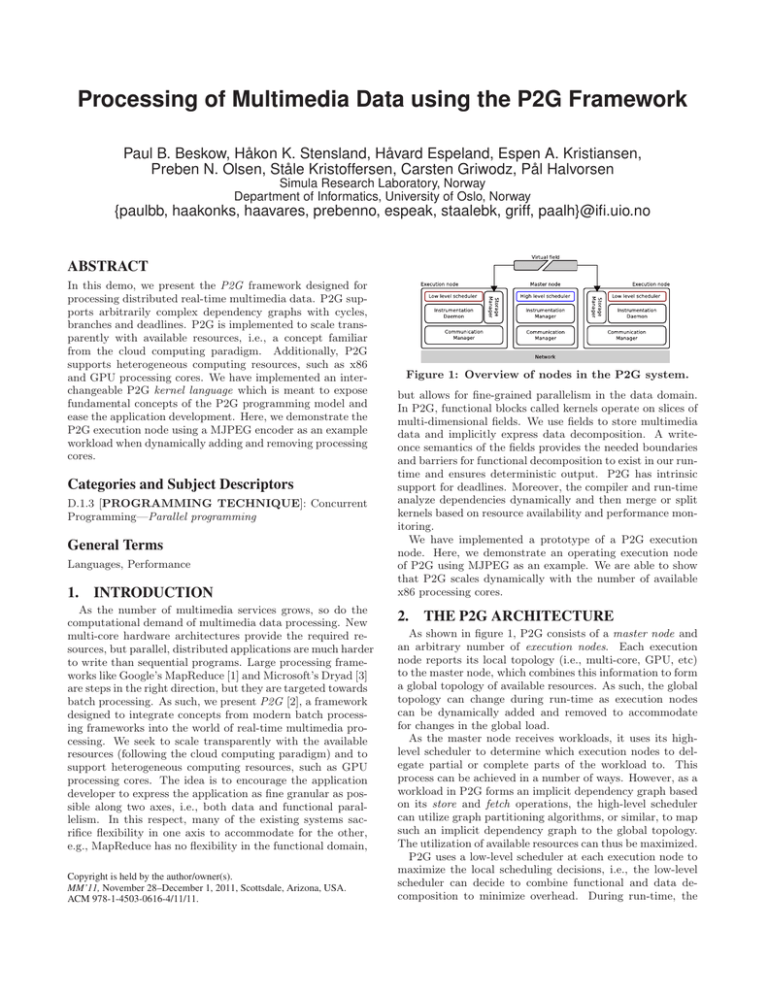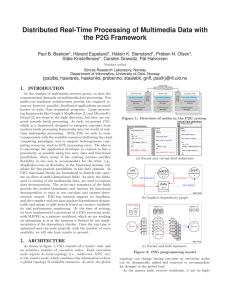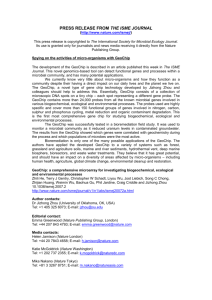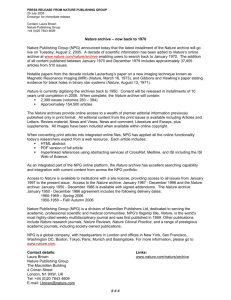Processing of Multimedia Data using the P2G Framework
advertisement

Processing of Multimedia Data using the P2G Framework
Paul B. Beskow, Håkon K. Stensland, Håvard Espeland, Espen A. Kristiansen,
Preben N. Olsen, Ståle Kristoffersen, Carsten Griwodz, Pål Halvorsen
Simula Research Laboratory, Norway
Department of Informatics, University of Oslo, Norway
{paulbb, haakonks, haavares, prebenno, espeak, staalebk, griff, paalh}@ifi.uio.no
ABSTRACT
In this demo, we present the P2G framework designed for
processing distributed real-time multimedia data. P2G supports arbitrarily complex dependency graphs with cycles,
branches and deadlines. P2G is implemented to scale transparently with available resources, i.e., a concept familiar
from the cloud computing paradigm. Additionally, P2G
supports heterogeneous computing resources, such as x86
and GPU processing cores. We have implemented an interchangeable P2G kernel language which is meant to expose
fundamental concepts of the P2G programming model and
ease the application development. Here, we demonstrate the
P2G execution node using a MJPEG encoder as an example
workload when dynamically adding and removing processing
cores.
Categories and Subject Descriptors
D.1.3 [PROGRAMMING TECHNIQUE]: Concurrent
Programming—Parallel programming
General Terms
Languages, Performance
1. INTRODUCTION
As the number of multimedia services grows, so do the
computational demand of multimedia data processing. New
multi-core hardware architectures provide the required resources, but parallel, distributed applications are much harder
to write than sequential programs. Large processing frameworks like Google’s MapReduce [1] and Microsoft’s Dryad [3]
are steps in the right direction, but they are targeted towards
batch processing. As such, we present P2G [2], a framework
designed to integrate concepts from modern batch processing frameworks into the world of real-time multimedia processing. We seek to scale transparently with the available
resources (following the cloud computing paradigm) and to
support heterogeneous computing resources, such as GPU
processing cores. The idea is to encourage the application
developer to express the application as fine granular as possible along two axes, i.e., both data and functional parallelism. In this respect, many of the existing systems sacrifice flexibility in one axis to accommodate for the other,
e.g., MapReduce has no flexibility in the functional domain,
Copyright is held by the author/owner(s).
MM’11, November 28–December 1, 2011, Scottsdale, Arizona, USA.
ACM 978-1-4503-0616-4/11/11.
Figure 1: Overview of nodes in the P2G system.
but allows for fine-grained parallelism in the data domain.
In P2G, functional blocks called kernels operate on slices of
multi-dimensional fields. We use fields to store multimedia
data and implicitly express data decomposition. A writeonce semantics of the fields provides the needed boundaries
and barriers for functional decomposition to exist in our runtime and ensures deterministic output. P2G has intrinsic
support for deadlines. Moreover, the compiler and run-time
analyze dependencies dynamically and then merge or split
kernels based on resource availability and performance monitoring.
We have implemented a prototype of a P2G execution
node. Here, we demonstrate an operating execution node
of P2G using MJPEG as an example. We are able to show
that P2G scales dynamically with the number of available
x86 processing cores.
2.
THE P2G ARCHITECTURE
As shown in figure 1, P2G consists of a master node and
an arbitrary number of execution nodes. Each execution
node reports its local topology (i.e., multi-core, GPU, etc)
to the master node, which combines this information to form
a global topology of available resources. As such, the global
topology can change during run-time as execution nodes
can be dynamically added and removed to accommodate
for changes in the global load.
As the master node receives workloads, it uses its highlevel scheduler to determine which execution nodes to delegate partial or complete parts of the workload to. This
process can be achieved in a number of ways. However, as a
workload in P2G forms an implicit dependency graph based
on its store and fetch operations, the high-level scheduler
can utilize graph partitioning algorithms, or similar, to map
such an implicit dependency graph to the global topology.
The utilization of available resources can thus be maximized.
P2G uses a low-level scheduler at each execution node to
maximize the local scheduling decisions, i.e., the low-level
scheduler can decide to combine functional and data decomposition to minimize overhead. During run-time, the
master node will collect statistics on resource usage from
all execution nodes, which all run an instrumentation daemon to acquire this information. The master node can then
combine this run-time instrumentation data with the implicit dependency graph derived from the source code and
the global topology to make continuous refinements to the
high-level scheduling decisions. As such, P2G relies on its
combination of a high-level scheduler, low-level schedulers,
instrumentation data and the global topology to make best
use of the performance of several (possibly heterogeneous)
cores in a distributed system.
read
splitYUV
VLC
write
yDCT
instances = a *
num_mblocks
instances=a
fetch Yinput(a)[x]
instances=a
Yresult
size=
num_mblocks
size=
num_mblocks
store Yinput(a)
fetch Yresult(a)
Age loop
(a) Implicit dependency graph for the Y-component
Age(a)
a=0
...
Age(a)
Age(a)
a=n
a=0
a=0
a=1
...
a=n
Y
...
a=n
a=1
Y
U
%{
read-code
splitYUV
%}
V
a=2
x = numY
U
x = numU
V
x = numV
...
a=n
%{
DCT-code
%}
%{
VLC-code
write-code
%}
a=2
...
a=n
store code field
fetch
3 cores
2 cores
Figure 3: Screenshot of the MJPEG demo.
for heterogeneous architectures and distribution mechanisms
are ongoing work.
3.
store Yresult(a)[x]
Yinput
4 cores
Age loop
(b) Kernel and field instances
Figure 2: Programming model (MJPEG example)
P2G provides a kernel language for the programmer to
write their application in, which they do by writing isolated,
sequential pieces of code (kernels). Kernels operate on slices
of fields through fetch and store operations and have native
code embedded within them. In this model, we encourage
the programmer to specify the inherent parallelism in their
application in as fine a granularity as possible in the domains
of both functional and data decomposition.
The multi-dimensional fields offer a natural way to express multimedia data, and provide a direct way for kernels
to fetch fine granular data slices. A write-once semantics of
the fields provides deterministic output, though not necessarily deterministic execution of individual kernels. Given
write-once semantics, iteration is supported in P2G by introducing the concept of aging, as seen in figure 2(a), where
storing and fetching to the same field position, at different
ages, makes it possible to form loops. The write-once semantics also provides natural boundaries and barriers for
functional decomposition, as the low-level scheduler can analyze the dependencies of a kernel instance to determine if
it is ready for execution. Furthermore, the compiler and the
run-time can analyze dependencies dynamically and merge
or split kernels based on resource availability and performance monitoring.
Given a workload specified using the P2G kernel language,
P2G is designed to compile the source code for a number of
heterogeneous architectures. At the time of writing, P2G
consists of what we call an execution node, which is capable
of executing workloads on a single x86 multi-core node. As
such, the implementation of a high-level scheduler, support
WORKLOAD
We have implemented several simple workloads used in
multimedia processing, such as matrix multiplication, kmeans clustering to test the prototype implementation of
P2G. In this demo, we will focus on our implementation of
the MJPEG encoder.
Figure 2(b) shows how the MJPEG encoding process is
split into kernels and their running instances. YUV-input
video are read into 8x8 macro-blocks and stored in three
global fields, by the read + splitYUV kernel. For example,
given the CIF resolution of 352x288 pixels per frame used in
our tests, this generates 1584 macro-blocks of Y (luminance)
data, each with 64 pixel values. This makes it possible to
create 1584 instances per age of the DCT kernel transforming the luminance component of the picture. Each of these
kernel instances stores the DCT’ed macro-block into global
result fields. Finally, the VLC + write kernel does variable
length coding and stores the MJPEG bit-stream to disk.
4.
DEMONSTRATION
In this demo, we will explain and discuss the P2G ideas for
multimedia processing. A screenshot of the MJPEG encoder
running in the P2G framework is shown in figure 3. We
are able to dynamically add and remove processing cores
available to the framework. To show the performance, we
live plot the achieved frame-rate from the encoder (left) and
show a preview of the encoded video stream (right) as seen
in the screenshot.
Acknowledgements
This work has been performed in the context of the iAD centre for Research-based Innovation (project number 174867)
funded by the Norwegian Research Council.
5.
REFERENCES
[1] Dean, J., and Ghemawat, S. Mapreduce: simplified
data processing on large clusters. In Proc. of USENIX
OSDI (2004), pp. 10–10.
[2] Espeland, H., Beskow, P. B., Stensland, H. K.,
Olsen, P. N., Kristoffersen, S., Griwodz, C.,
and Halvorsen, P. P2G: A framework for distributed
real-time processing of multimedia data. In Proc. of
SRMPDS 2011 (2011), IEEE.
[3] Isard, M., Budiu, M., Yu, Y., Birrell, A., and
Fetterly, D. Dryad: distributed data-parallel
programs from sequential building blocks. In Proc. of
ACM EuroSys (2007), ACM, pp. 59–72.








